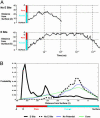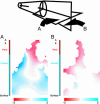Diffusion of nucleoside triphosphates and role of the entry site to the RNA polymerase II active center
- PMID: 15574497
- PMCID: PMC536049
- DOI: 10.1073/pnas.0408168101
Diffusion of nucleoside triphosphates and role of the entry site to the RNA polymerase II active center
Abstract
Nucleoside triphosphates (NTPs) diffuse to the active center of RNA polymerase II through a funnel-shaped opening that narrows to a negatively charged pore. Computer simulation shows that the funnel and pore reduce the rate of diffusion by a factor of approximately 2 x 10(-7). The resulting limitation on the rate of RNA synthesis under conditions of low NTP concentration may be overcome by NTP binding to an entry site adjacent to the active center. Binding to the entry site greatly enhances the lifetime of an NTP in the active center region, and it prevents "backtracking" and the consequent occlusion of the active site.
Figures




References
-
- Zhang, G., Campbell, E. A., Minakhin, L., Richter, C., Severinov, K. & Darst, S. A. (1999) Cell 98, 811–824. - PubMed
-
- Cramer, P., Bushnell, D. A., Fu, J., Gnatt, A. L., Maier-Davis, B., Thompson, N. E., Burgess, R. R., Edwards, A. M., David, P. R. & Kornberg, R. D. (2000) Science 288, 640–649. - PubMed
-
- Bushnell, D. A., Westover, K. D., Davis, R. E. & Kornberg, R. D. (2004) Science 303, 983–988. - PubMed
-
- Temiakov, D., Patlan, V., Anikin, M., McAllister, W. T., Yokoyama, S. & Vassylyev, D. G. (2004) Cell 116, 381–391. - PubMed
-
- Yin, Y. W. & Steitz, T. A. (2004) Cell 116, 393–404. - PubMed
Publication types
MeSH terms
Substances
Grants and funding
LinkOut - more resources
Full Text Sources

